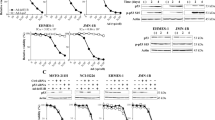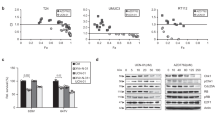Abstract
Therapeutic approaches which are effective in tumour cells resistant to conventional chemotherapy would be of value. An E1B 55 kDa-deleted adenovirus (ONYX-015) induces lysis in cells with mutant p53, although the specificity of these observations for different cell types is unclear. We have used a matched set of drug-resistant human ovarian tumour cell lines to examine the potential of ONYX-015 for preferential replication and lysis of drug-resistant ovarian tumour cells with documented alterations in p53 function. Marked preferential replication of ONYX-015 is observed after infection of mutant p53 transfectant and cisplatin-resistant derivatives, compared to the wild-type p53 expressing parental A2780 line. Infection causes increased cytopathic effects in vitro and inhibition of tumour growth in vivo of the drug-resistant derivatives, but not the parental line. In apparent contrast, increased apoptosis and reduced clonogenic survival is induced by ONYX-015 infection of the chemosensitive parental cell line. ONYX-015 induces increased pro-apoptotic BAX and reduced anti-apoptotic BCLXL in parental cells, but not in the resistant derivative A2780/cp70. We propose that induction of apoptosis is one factor which prevents ONYX-015 spread and cytolysis after infection of chemosensitive cells, while it is the failure to engage apoptosis in drug-resistant cells that allows preferential viral replication, spread and cytolysis.
This is a preview of subscription content, access via your institution
Access options
Subscribe to this journal
Receive 12 print issues and online access
$259.00 per year
only $21.58 per issue
Buy this article
- Purchase on Springer Link
- Instant access to full article PDF
Prices may be subject to local taxes which are calculated during checkout




Similar content being viewed by others
References
Reed E et al. Paclitaxel, cisplatin, and cyclophosphamide in human ovarian cancer: molecular rationale and early clinical results Semin Oncol 1995 22: 90–96
Buttitta F et al. p53 alterations are predictive of chemoresistance and aggressiveness in ovarian carcinomas: a molecular and immunohistochemical study Br J Cancer 1997 75: 230–235
Anthoney DA et al. Microsatellite instability, apoptosis and loss of p53 function in drug resistant tumour cells Cancer Res 1996 56: 1374–1381
Bischoff JR et al. An adenovirus mutant that replicates selectively in p53-deficient human tumour cells Science 1996 274: 373–376
Heise C et al. Onyx-015, an E1B gene attenuated adenovirus, causes tumour-specific cytolysis and antitumoural efficacy that can be augmented by standard chemotherapeutic agents Nature Med 1997 3: 639–645
FD Goodrum, Ornelles DA . p53 status does not determine outcome of E1B 55-kilodalton mutant adenovirus lytic infection J Virol 1998 72: 9479–9490
Ridgway PJ, Hall AR, Myers CJ, Braithwaite AW . p53/E1b58kDa complex regulates adenovirus replication Virology 1997 237: 404–413
Hall AR, Dix BR, O'Carroll SJ, Braithwaite AW . p53-dependent cell death/apoptosis is required for a productive adenovirus infection Nature Med 1998 4: 1068–1072
NA Jones et al. Cisplatin and paclitaxel induced apoptosis of human ovarian carcinoma cells and the relationship between bax and bak up-regulation and the functional status of p53 Mol Pharmacol 1998 53: 819–826
Vasey PA et al. Cisplatin, camptothecin and taxol sensitivities of cells with p53-associated multidrug resistance Mol Pharmacol 1996 50: 1536–1540
McDonald AC, Brown R . Induction of p53-dependent and p53-independent cellular responses by topoisomerase 1 inhibitors Br J Cancer 1998 78: 745–751
McIlwrath AJ, Vasey PA, Ross GM, Brown R . Cell cycle arrests and radiosensitivity of human tumour cell lines: dependence on wild-type p53 for radiosensitivity Cancer Res 1994 54: 3718–3722
Brown R et al. hMLH1 expression and cellular responses of ovarian tumour cells to treatment with cytotoxic anticancer agents Oncogene 1997 15: 45–52
Goodrum FD, Ornelles DA . The early region 1B 55-kilodalton oncoprotein of adenovirus relieves growth restrictions imposed on viral replication by the cell cycle J Virol 1997 71: 546–561
Kolls J, Peppel K, Silva M, Beutler B . Prolonged and effective blockage of tumour necrosis factor activity through adenovirus-mediated gene transfer Proc Natl Acad Sci USA 1994 91: 215–219
Frey T . Correlated flow cytometric analysis of terminal events in apoptosis reveals the absence of some changes in some model systems Cytometry 1997 28: 253–263
Debbas M, White E . Wild type p53 mediates apoptosis by E1A, which is inhibited by E1B Genes Dev 1993 7: 546–554
Turnell AS, Grand RJA, Gallimore PH . The replicative capacities of large E1B-null group A and group C adenoviruses are independent of host cell p53 status J Virol 1999 73: 2074–2083
Querido E et al. Regulation of p53 levels by the E1B 55-kilodalton protein and E4orf6 in adenovirus-infected cells J Virol 1997 71: 3788–3798
Steegenga WT et al. The large E1B protein together with the E4orf6 protein targets p53 for active degradation in adenovirus infected cells Oncogene 1998 16: 349–357
Grand RJA, Grant ML, Gallimore PH . Enhanced expression of p53 in human cells infected with mutant adenoviruses Virology 1994 203: 229–240
Levkau B et al. Cleavage of p21CIP1/Waf1 and p27Kip1 mediates apoptosis in endothelial cells through activation of cdk2: role of a caspase cascade Mol Cell 1998 1: 553–563
T Dobner, Horikoshi N, Rubenwolf S, Shenk T . Blockage by adenovirus E4orf6 of transcriptional activation by the p53 tumour suppressor Science 1996 272: 1470–1473
Ganly I et al. A phase I study of Onyx-015, and E1B attenuated adenovirus, administered intratumourally in patients with recurrent tumours of the head and neck Clin Cancer Res 2000 6: 798–806
Barker DD, Berk AJ . Adenovirus proteins from both E1B reading frames are required for transformation of rodent cells by viral infection and DNA transfection Virology 1987 156: 107–121
Acknowledgements
We would like to thank Professor SB Kaye, Dr D Stuart and Dr D Kirn for advice and helpful discussion throughout this study and Dr Wilma Steegenga for supplying the Ad5CMVlacZ virus. Onyx Pharmaceuticals supported IG. RB is supported by the Cancer Research Campaign (UK).
Author information
Authors and Affiliations
Rights and permissions
About this article
Cite this article
Ganly, I., Kim, Y., Hann, B. et al. Replication and cytolysis of an E1B-attenuated adenovirus in drug-resistant ovarian tumour cells is associated with reduced apoptosis. Gene Ther 8, 369–375 (2001). https://doi.org/10.1038/sj.gt.3301402
Received:
Accepted:
Published:
Issue Date:
DOI: https://doi.org/10.1038/sj.gt.3301402
Keywords
This article is cited by
-
Oncolytic adenovirus targeting cyclin E overexpression repressed tumor growth in syngeneic immunocompetent mice
BMC Cancer (2015)
-
Impact of novel oncolytic virus HF10 on cellular components of the tumor microenviroment in patients with recurrent breast cancer
Cancer Gene Therapy (2012)
-
RNA interference-mediated knockdown of p21WAF1 enhances anti-tumor cell activity of oncolytic adenoviruses
Cancer Gene Therapy (2009)
-
Anticancer activity of oncolytic adenovirus vector armed with IFN-α and ADP is enhanced by pharmacologically controlled expression of TRAIL
Cancer Gene Therapy (2008)
-
Oncolytic adenoviruses – selective retargeting to tumor cells
Oncogene (2005)



